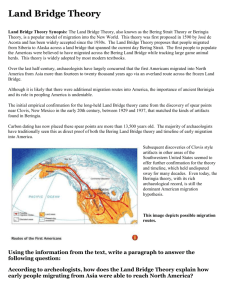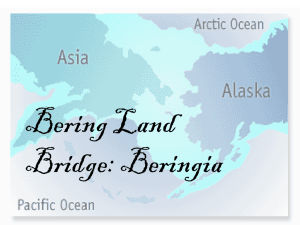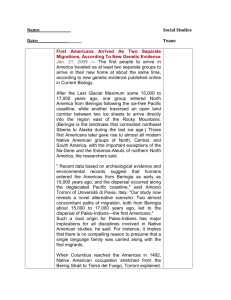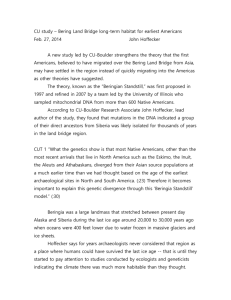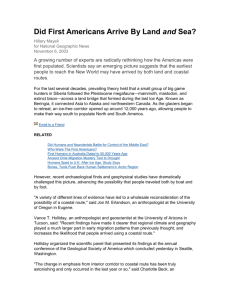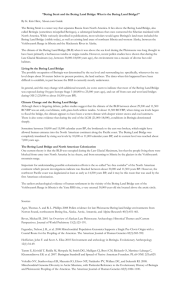Land Bridge Theory Synopsis: The Land Bridge Theory, also known
advertisement
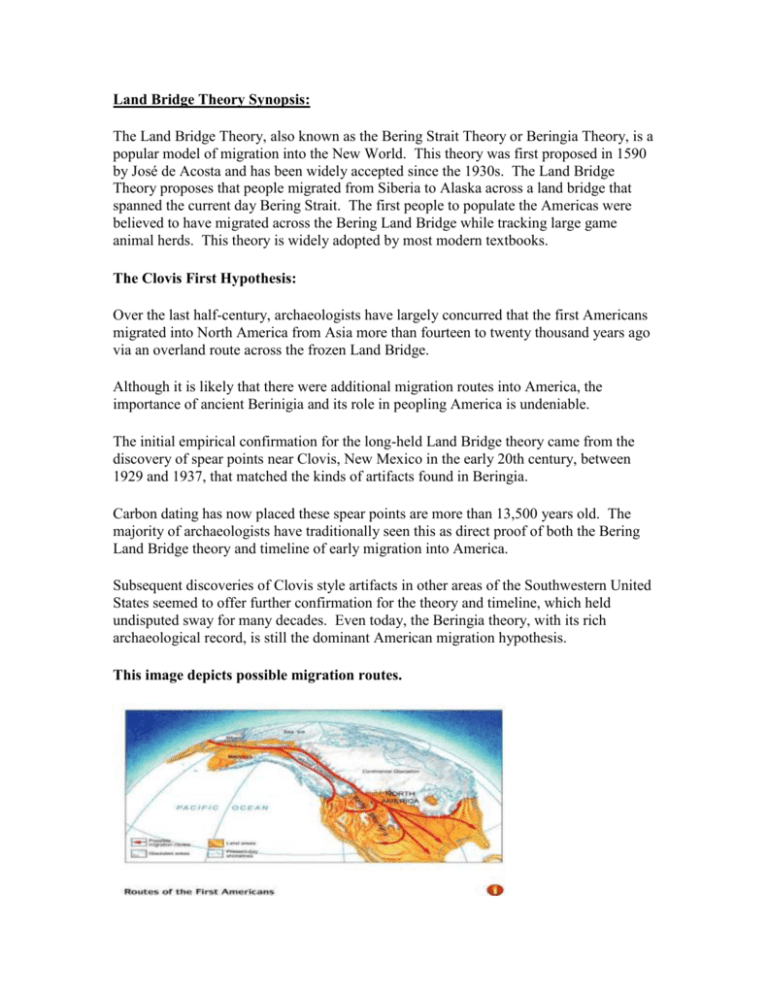
Land Bridge Theory Synopsis: The Land Bridge Theory, also known as the Bering Strait Theory or Beringia Theory, is a popular model of migration into the New World. This theory was first proposed in 1590 by José de Acosta and has been widely accepted since the 1930s. The Land Bridge Theory proposes that people migrated from Siberia to Alaska across a land bridge that spanned the current day Bering Strait. The first people to populate the Americas were believed to have migrated across the Bering Land Bridge while tracking large game animal herds. This theory is widely adopted by most modern textbooks. The Clovis First Hypothesis: Over the last half-century, archaeologists have largely concurred that the first Americans migrated into North America from Asia more than fourteen to twenty thousand years ago via an overland route across the frozen Land Bridge. Although it is likely that there were additional migration routes into America, the importance of ancient Berinigia and its role in peopling America is undeniable. The initial empirical confirmation for the long-held Land Bridge theory came from the discovery of spear points near Clovis, New Mexico in the early 20th century, between 1929 and 1937, that matched the kinds of artifacts found in Beringia. Carbon dating has now placed these spear points are more than 13,500 years old. The majority of archaeologists have traditionally seen this as direct proof of both the Bering Land Bridge theory and timeline of early migration into America. Subsequent discoveries of Clovis style artifacts in other areas of the Southwestern United States seemed to offer further confirmation for the theory and timeline, which held undisputed sway for many decades. Even today, the Beringia theory, with its rich archaeological record, is still the dominant American migration hypothesis. This image depicts possible migration routes. [Excerpt from The 1st Americans] In Brief: Archaeologists long thought the first Americans were the Clovis people, who were said to have reached the New World some 13,000 years ago from northern Asia. But fresh archaeological finds prove that humans reached the Americas thousands of years before that. These discoveries, along with insights from genetics and geology, have prompted reconsideration of where these pioneers came from, when they arrived, and what route they took into the New World. Genetic Trails: In more than a dozen studies geneticists examined modern and ancient DNA samples from Native Americans, looking for telltale genetic mutations or markers that define major human lineages known as haplogroups. They found that native peoples in the Americas stemmed from four major founding maternal haplogroups -- A, B, C and D -and two major founding paternal haplogroups -- C and Q. To find the probably source of these haplogroups, the teams then searched for human populations in the Old World whose genetic diversity encompassed all the lineages. Only the modern inhabitants of southern Siberia, from the Altai Mountains in the west to the Amur River in the east, matched this genetic profiles, a finding that strongly indicates that the ancestors of the first Americans came from an East Asian homeland. Above: mtDNA - (mitochondrial) maternal lineage Above: yDNA - (y chromosome) paternal lineage This evidence confirmed what most archaeologists suspected about the location of this homeland. It also strongly suggested that the timing proposed in the Clovis First scenario was wrong. Geneticists now calculate, based on mutation rates in human DNA that the ancestors of the Native Americans parted from their kin in their East Asian homeland sometime between 25,000 and 15,000 years ago -- a difficult time for a great northern migration. Huge glaciers capped the mountain valleys of northeastern Asia, at the same time massive ice sheets mantled most of Canada, New England and several northern states. Indeed, reconstructions of past climate based on data preserved in ice cores from Greenland and on measurements of past global sea levels show that these ice sheets reached their maximum extent in the last glacial period between at least 22,000 and 19,000 years ago. "But these folks were extraordinarily adept at moving over the landscape," says David Meltzer, an archeologist at Southern Methodist University. "Their entire existence -- and the existence of everyone they knew and the existence of their ancestors -- was about adapting. They had a toolbox of tactics and strategies." Dressed in warm, tailored hide garments stitched together with sinew and bone needles and armed with an expert knowledge of nature, the ancestors of the Paleo-Americans entered an Arctic world without parallel today. The ice sheets in northern Europe and North America had locked up vast quantities of water, lowering sea level by more than 100 meters and exposing the continental shelves of northeastern Asia and Alaska. These newly revealed lands, together with adjacent regions in Siberia, Alaska and northern Canada, formed a landmass that joined the Old World seamlessly to the New. Known today as Beringia, this landmass would have made a welcoming way station for pre-Clovis migrants. The air masses that swept over it were so dry they brought little snowfall, preventing the growth of ice sheets. As a result, grasses, sedges and other coldadapted plants thrived there, as shown by plan remains found preserved under a layer of volcanic ash in northwestern Alaska and in the frozen intestines of large herbivores that once grazed in Beringia. These plans formed an arid tundra-grassland, and there woolly mammoths weighing as much as nine tons grazed, as did giant ground sloths, steppe bison, musk ox and caribou. Genetic studies of modern Steller's sea lion populations suggest that this sea mammal likely hauled out on the rocks along Beringia's islandstudded south shore. So the migrants may have had their pick not only of terrestrial mammals but also of seafaring ones. Received wisdom holds that the trailblazers hurried across Beringia to reach warmer, more hospitable lands. Some researchers, however, think the journey could have been a more leisurely affair. The major genetic lineages of Native Americans possess many widespread founding haplotypes -- combinations of closely linked DNA sequences on individual chromosomes that are often inherited together -- that their closes Asian kin lack. This suggests that the earliest Americans paused somewhere en route to the New World, evolving in isolation for thousands of years before entering the Americas. The most likely spot for the Kinetic Incubator is Beringia. There the migrants could conceivably have been cut off from their Asian kin as the climate cooled some 22,000 years ago, forcing Siberian bands to retreat south. Whether the migrants cooled their heels in Beringia, however, or somewhere else in northeastern Asia, people eventually began striking off farther east and south. A warming trend began slowly shrinking North America's ice sheets some 19,000 years ago, gradually creating two passable routes to the south and opening the possibility of multiple early migrations. According to several studies conducted over the past decade on the geographic distribution of genetic diversity in modern indigenous Americans, the earliest of these migrants started colonizing the New World between 18,000 and 15,000 years ago -- a date that fits well with emerging archaeological evident of pre-Clovis colonists.
